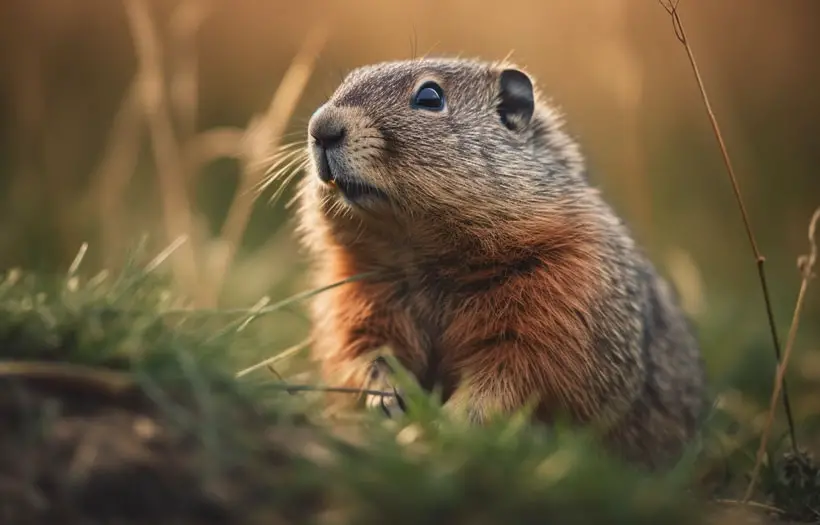Mystery Uncovered – How do Gophers Breathe Underground?
Living underground is challenging. Especially humans. When we think about leaving underneath the surface, we start to feel suffocated.
But nature has shown its charisma. It has equipped some animals with unique characteristics and remarkable adaptation capabilities to deal with the underground environment. One of the prominent animals is the gopher, which can survive in thin and low-airflow conditions beneath the soil.
So, how do gophers breathe underground? Gophers have specialized lungs equipped with more blood vessels, allowing them to extract oxygen more efficiently. Also, they have a high red blood cell concentration, which helps ensure efficient oxygen transportation throughout their bodies.
Another crucial thing is that their tunnel system allows for appropriate ventilation to ensure the required airflow from the inlets and outlets. So, despite the associated challenges, these creatures have managed to thrive in their underground homes, showcasing nature’s incredible resilience and adaptability.
Not limited to these, the gopher’s unique physical and behavioral characteristics are highly adaptable to unfriendly environmental conditions. In this article, we are going to discuss those matters to increase our understanding of this creature.
Gopher Anatomy and Respiratory System
Well, now we know that gophers are naturally blessed to breathe in an underground environment. But how do they do that? What respiratory anatomy is behind that? Let’s check it out.

Respiratory Anatomy of Gophers
The gopher respiratory system consists of specialized lungs, trachea, and bronchi adapted to the burrow systems’ low-oxygen and high-carbon dioxide conditions.
Lungs
The lungs of gophers are relatively large in comparison to their overall body size. And they are entitled to deal with high concentrations of red blood cells. This context facilitates oxygen exchange more efficiently.
In addition to these, these pests’ lungs have a greater number of blood vessels, which supports a higher amount of oxygen absorption. All these enhanced organ features ensure that gophers can get enough oxygen effortlessly from the limited air environment.
Trachea and Bronchi
Without telling about the trachea and bronchi, the gophers’ respiratory system discussion won’t be completed. The trachea, a pipeline for passing air, is equipped with cilia. Here, the cilia have a crucial role in preventing the entrance of the debris, which is mixed with the inflow air.
That means this organ functions to support the inhabitance of gophers in an underground condition. Here, the oxygen-rich air comes through the soil gaps and can contain microscopically small particles. The bronchi, the branches of the trachea, are very short and wide.
This formation allows the bronchi to allow faster and more adequate airflow movement.
Diaphragm
Like in every other mammal, the diaphragm is a core component of the gopher’s respiratory system. It assists the respiratory system in controlling the inflow and outflow of air from and to the lungs. Gopher’s diaphragm is a thin, dome-shaped muscle.
During its contraction, it gets flattened and triggers the expansion of the thoracic cavity. This action creates a vacuum to drag air into the lungs. Oppositely, when it expands, the thoracic cavity contracts and forces air out of the lungs.
How Gophers Extract Oxygen?
Gophers’ lungs, the main breathing component, are highly efficient in making the animal survive in low-oxygen conditions. The core points are expressed below to make it easier to understand how gophers extract oxygen from the air in underground burrows.

- When the gopher species inhales, tunnel air starts to enter its respiratory system through the mouth and nose.
- After entering, the inflow of air passes through the trachea, leaving microscopic particles.
- The fresh air enters the bronchi, the branches of the trachea, and passes toward the lungs.
- The tissues of the lungs absorb oxygen.
- Lastly, through the use of blood vessels, oxygen is transported throughout the body.
Gopher Behavior Underground
Gophers live underground because of their natural characteristics. The underground life assists them in being safe from predators while accessing plants. But it also comes with a vital challenge for their respiration due to the low-oxygen condition.

To ensure underground survival, gophers have two particular tools. One is the evolved adaptation of their respiratory organs, and another is their capability to create tunnels ensuring airflow. So let’s check out gopher behavior underground in detail now.
Burrowing Behavior
In terms of burrowing behavior, gophers create ventilation shafts in their burrows to ensure airflow passage. Each shaft has inlets and outlets and a main horizontal tunnel. Here, each main horizontal tunnel has multiple branches.
The whole system acts as an airflow passage, while the topsoil mounds act as an air extraction tool. Topsoil mounds obstruct the airflow on the ground, and the associated tiny openings are entitled to take the outside air into the tunnel.
In short, gophers can thrive in their underground habitats by creating ventilation shafts, adapting their respiratory systems, and conserving oxygen when resources are scarce.
Burrow Formation
Gophers’ tunnel contains various components. Below are the details.
- Soil Mounds: Gophers create soil mounds to catch the ground’s air.
- Ventilation shafts: A vertical tunnel to transport the outside air to the horizontal passages.
- Horizontal tunnels: These tunnels ensure continuous airflow for the gopher population.
- Air Plugs: Apart from soil mounds, gophers use vegetables and plants to plug the airflow and maintain a higher oxygen concentration in the tunnel air.
- Multiple inlets and outlets: Multiple openings allow ample air circulation.
Challenges to Maintaining Oxygen Levels and Removing Carbon Dioxide
The gophers’ underground tunnels, with only a few openings, come up with an enormous amount of challenges. Let’s check in on the details.

Oxygen Level Issue
First of all, underground habitats are not directly exposed to surface airflow. And it leads to a limited amount of airflow, i.e., a degraded oxygen level.
Secondly, in association with the low volume of fresh air, the tunnels inside oxygen levels can deplete. It is due to the respiration and microbial activity of living gophers.
Another influential factor in oxygen levels is the number of gophers living within a particular tunnel system. If the tunnel system is not that large and is not equipped with the required amount of openings, shafts, etc., the oxygen levels will be very low.
Carbon Dioxide Removing Issue
Below is a list of the issues in which we explain how gophers face challenges in dealing with the released carbon dioxide.
- Limited air exchange: Gophers live in underground tunnels, and the inside environment is separated from direct airflow. In this case, there is a limited exchange of carbon dioxide with the surface air.
- High metabolic rate: Gophers eat a lot, and their high metabolic rate triggers more carbon dioxide production as a waste product of respiration.
- Limited space: Gophers’ burrow systems are relatively small and compact, which causes critical dissipation and results in the accumulation of carbon dioxide in the tunnel system.
Gopher Adaptations to Underground Life
Gophers are naturally endowed with some physical traits that make gopher adaptations to underground life well-suited. The traits include using the senses of touch, smell, hearing, etc. to navigate through the tunnel system. That protects them from predators, searching for food, etc.

Additionally, gophers’ underground living context is vitally dependent on their burrowing behavior and physical adaptability.
Adaptations in Respiratory Anatomy
Gophers’ inhabitance of subterranean environments is facilitated by their developed animal respiratory anatomy. The associated adaptation allows gophers to extract oxygen effectively.
Also, they have several vessels in their lungs that carry high-density blood, facilitating the enhanced exchange of oxygen and carbon dioxide. The lung size is also comparatively large, supporting the required extraction of oxygen.
Adaptation in Burrowing Behavior
Gophers are well-known as soil engineers; their burrowing behavior is a key adaptation for living underground. With their powerful front legs and claws, they can create a significant number of tunnels or tunnel extensions within a shorter period.
Again, their streamlined body shape allows them to move through the narrow tunnels. As part of their overall animal behavior, gophers typically construct extensive tunnel systems that can extend for several meters underground—their safe and secure shelter from outside risks.
Metabolic Rate
To overcome the challenges associated with living in a subterranean environment, gophers retain a higher metabolic rate for maintaining body temperature, digestion, and reproduction.
Amazingly, when there is an oxygen consumption shortage, they can slow down their metabolism and heart rate, enabling long-term survival.
Other Adaptations
Gophers are used to living on roots and tubers. And to deal with those, they are ornamented with specialized teeth that are adapted for gnawing.
However, another must-mention adaptability of gophers is that they can grow food in unfriendly conditions, which is a crucial need for surviving in a subterranean environment.
Respiration and Activity Levels

Here is a detailed discussion on respiration and activity levels.
Triggering Factors for Changes in Respiration and Activity Levels
The first triggering factor is temperature. When the temperature is low, they increase their activity level as well as their respiration rate. It is to generate more heat, keeping the body warm.
Oppositely, in the case of a hot temperature, they lower their respiration rate and activity level. In hot conditions, they used to rest in the tunnel without frequent movement.
The second triggering factor is humidity. In the case of higher humidity, gophers reduce their activity levels and spend more time in their burrows.
Managing Oxygen Needs and Energy Consumption
Gophers have developed many animal adaptations along with extensive borrowing behavior and physical adaptability. It is primarily done to manage their energy consumption and oxygen need in the nearly closed environment.

Energy Consumption
Gophers manage their energy consumption by adjusting their activity levels. The activity level adjustment is also integrated with the change in temperature and humidity. They reduce their energy consumption when there is low food availability.
However, they manage higher energy consumption by conserving energy from reduced metabolic and respiratory rates. In addition to these, gophers have highly efficient digestive systems. As such, they can extract as much energy as possible from the food they consume.
Oxygen Needs
Gophers meet their oxygen needs by enabling fresh air flow inside the tunnel. To ensure the airflow, they use diffusion through the soil, burrow ventilation through tunnel openings, and the use of a specialized respiratory system.
If you’re interested in how gophers breathe underground, be sure to check out our article on how gophers breathe underground. Additionally, if you’re dealing with gopher damage to your lawn, our article on gopher damage to lawn offers insights into how to identify and repair the damage caused by gophers. Finally, if you’re concerned about the possibility of gophers having rabies, our article on can gophers have rabies provides information on the likelihood of gophers carrying the disease and the symptoms to watch for. Our piece on gopher damage to lawn offers insights into how to identify and repair the damage caused by gophers, while our article on can gophers have rabies provides information on the potential risk of disease transmission.FAQs
Here are the answers to some of the most common questions.
Q: Do gophers ever come up to the surface to breathe?
No. Gophers do not need to come up to the surface to breathe. Gophers are, by nature, burrowing animals. They spend the majority of their time underground, in the tunnel systems. The associated adaptations allow them to breathe inside the tunnel.
However, they come to the surface to eat the above-ground parts of the plants.
Q: Can gophers survive in airtight environments?
No. But gophers are adapted to live in underground tunnel systems. In the tunnels, the airflow is poor, and the oxygen level is also low. Still, the associated adaptabilities allow gophers to survive there. But they cannot survive in completely airtight environments where there is no air.
Last Words
These pests are fascinating examples of adaptability in rodents. Their remarkable adaptations are visible through the associated burrowing behavior and underground habitats. Their unique respiratory anatomy is highly suitable for making them survive in low-air and low-oxygen conditions.
Also, by managing their energy consumption and oxygen needs, gophers can live in a subterranean environment. The mentioned characteristics, underground behavior, and adaptabilities demand an in-depth understanding as they are crucial for ecosystems.
Additionally, the understanding of the in-tunnel behavior of gropers helps us generate knowledge about how animals can survive in low airflow conditions.
Furthermore, studying and understanding how gophers adapt to their underground habitats allows researchers to gain crucial insights into the animals’ physiology. Moreover, it helps them understand the ecological behavior in their unique environments.
Finally, we see that more study of gophers is needed to develop an effective knowledge base on underground nutrient cycling and respiration in animals.




